BSBI MBA: Strategic Analysis of Virgin Airlines in the European Market
VerifiedAdded on 2022/10/14
|19
|5022
|242
Report
AI Summary
This report provides a strategic analysis of Virgin Airlines within the European airline industry, utilizing tools such as PESTLE, SWOT, and Porter’s Five Forces to evaluate the company's position and challenges. The analysis reveals the impact of political and economic factors, high competition, and supplier bargaining power on Virgin Airlines. The SWOT analysis highlights the company's strengths, including the support of Virgin Atlantic, and weaknesses related to pricing strategies. The report recommends implementing Porter’s generic strategies to achieve a competitive advantage and anticipates the airline's route expansion. It covers the organization's overview, industry context, and detailed analysis of external and internal factors affecting Virgin Airlines' performance in the European market. Desklib provides access to this report along with a wide range of past papers and solved assignments for students.
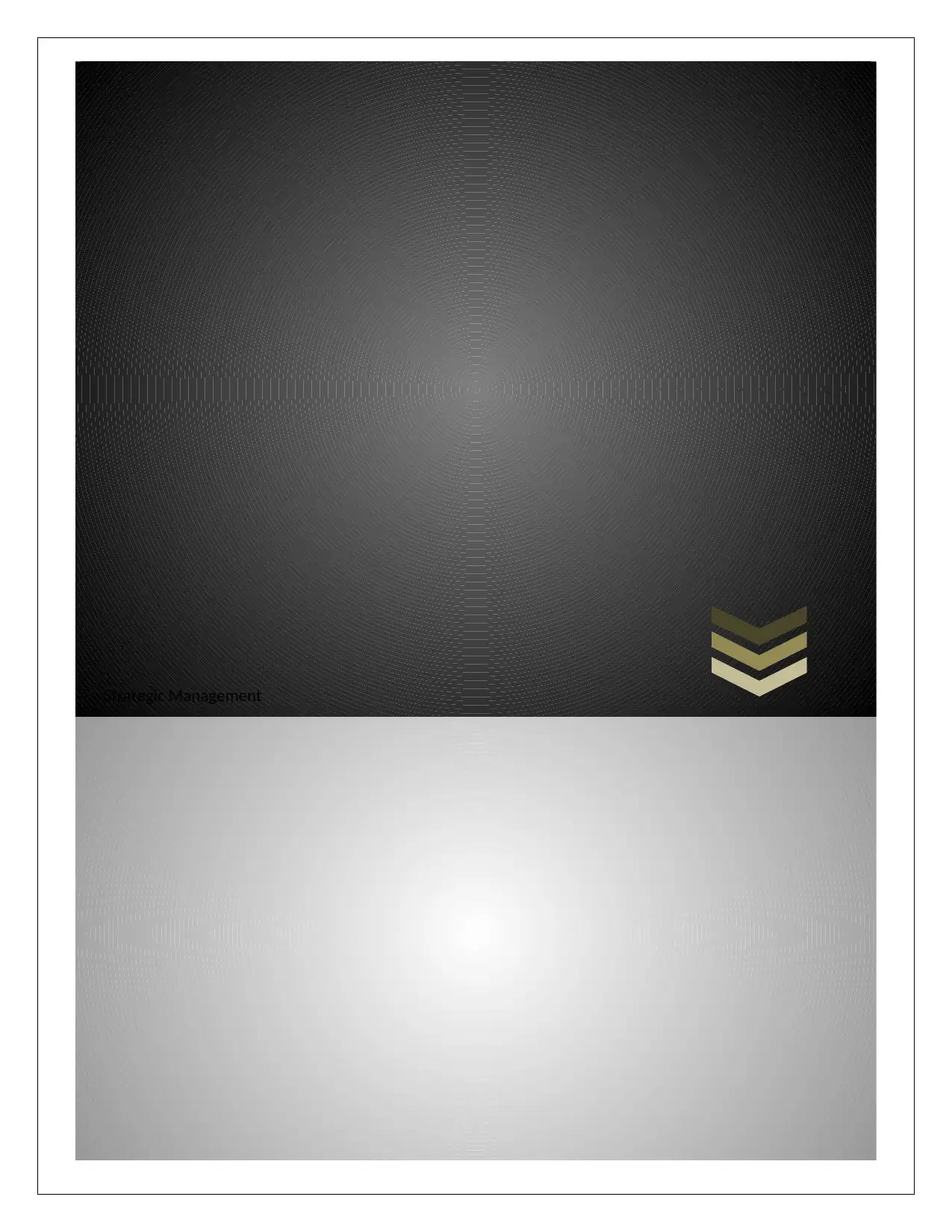
Strategic Management
Paraphrase This Document
Need a fresh take? Get an instant paraphrase of this document with our AI Paraphraser
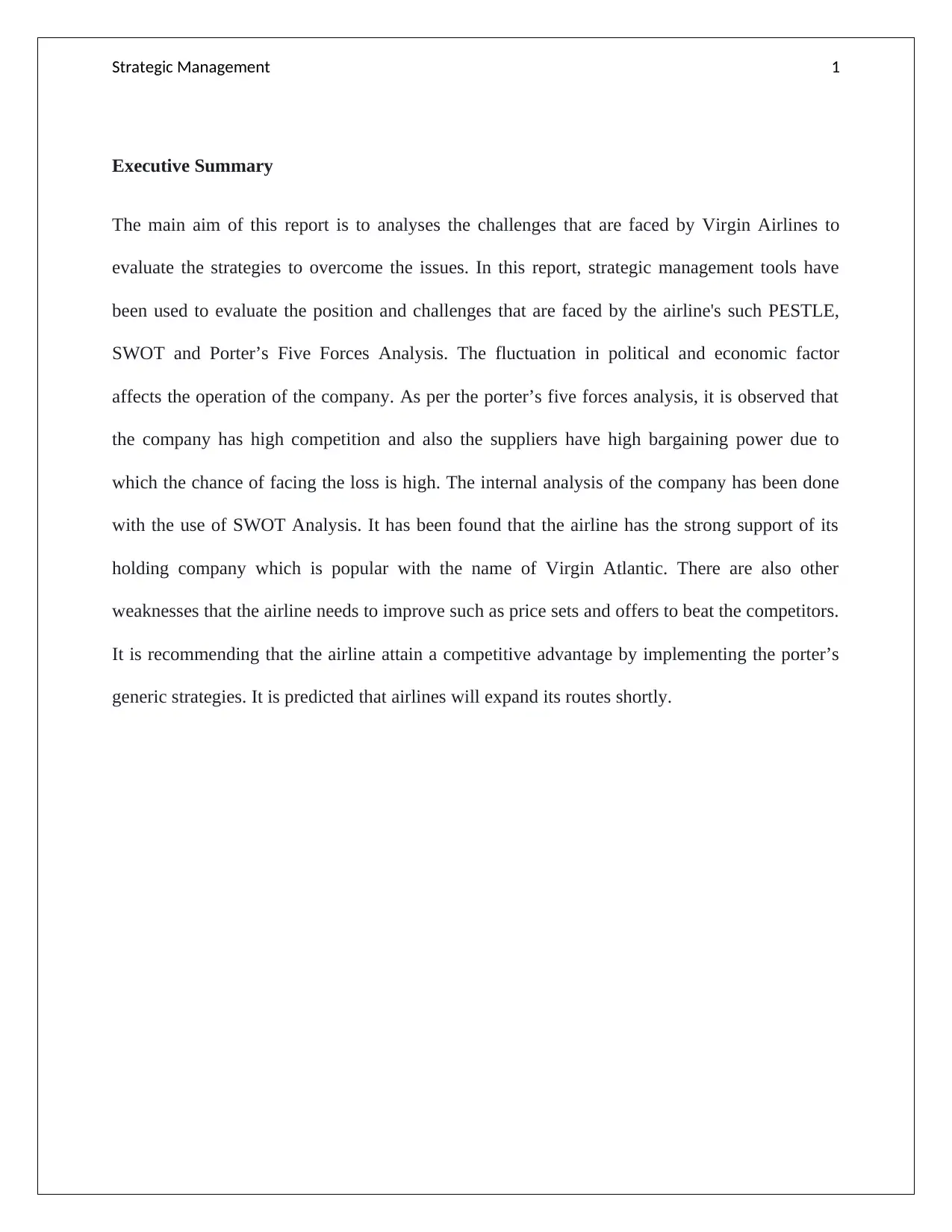
Strategic Management 1
Executive Summary
The main aim of this report is to analyses the challenges that are faced by Virgin Airlines to
evaluate the strategies to overcome the issues. In this report, strategic management tools have
been used to evaluate the position and challenges that are faced by the airline's such PESTLE,
SWOT and Porter’s Five Forces Analysis. The fluctuation in political and economic factor
affects the operation of the company. As per the porter’s five forces analysis, it is observed that
the company has high competition and also the suppliers have high bargaining power due to
which the chance of facing the loss is high. The internal analysis of the company has been done
with the use of SWOT Analysis. It has been found that the airline has the strong support of its
holding company which is popular with the name of Virgin Atlantic. There are also other
weaknesses that the airline needs to improve such as price sets and offers to beat the competitors.
It is recommending that the airline attain a competitive advantage by implementing the porter’s
generic strategies. It is predicted that airlines will expand its routes shortly.
Executive Summary
The main aim of this report is to analyses the challenges that are faced by Virgin Airlines to
evaluate the strategies to overcome the issues. In this report, strategic management tools have
been used to evaluate the position and challenges that are faced by the airline's such PESTLE,
SWOT and Porter’s Five Forces Analysis. The fluctuation in political and economic factor
affects the operation of the company. As per the porter’s five forces analysis, it is observed that
the company has high competition and also the suppliers have high bargaining power due to
which the chance of facing the loss is high. The internal analysis of the company has been done
with the use of SWOT Analysis. It has been found that the airline has the strong support of its
holding company which is popular with the name of Virgin Atlantic. There are also other
weaknesses that the airline needs to improve such as price sets and offers to beat the competitors.
It is recommending that the airline attain a competitive advantage by implementing the porter’s
generic strategies. It is predicted that airlines will expand its routes shortly.
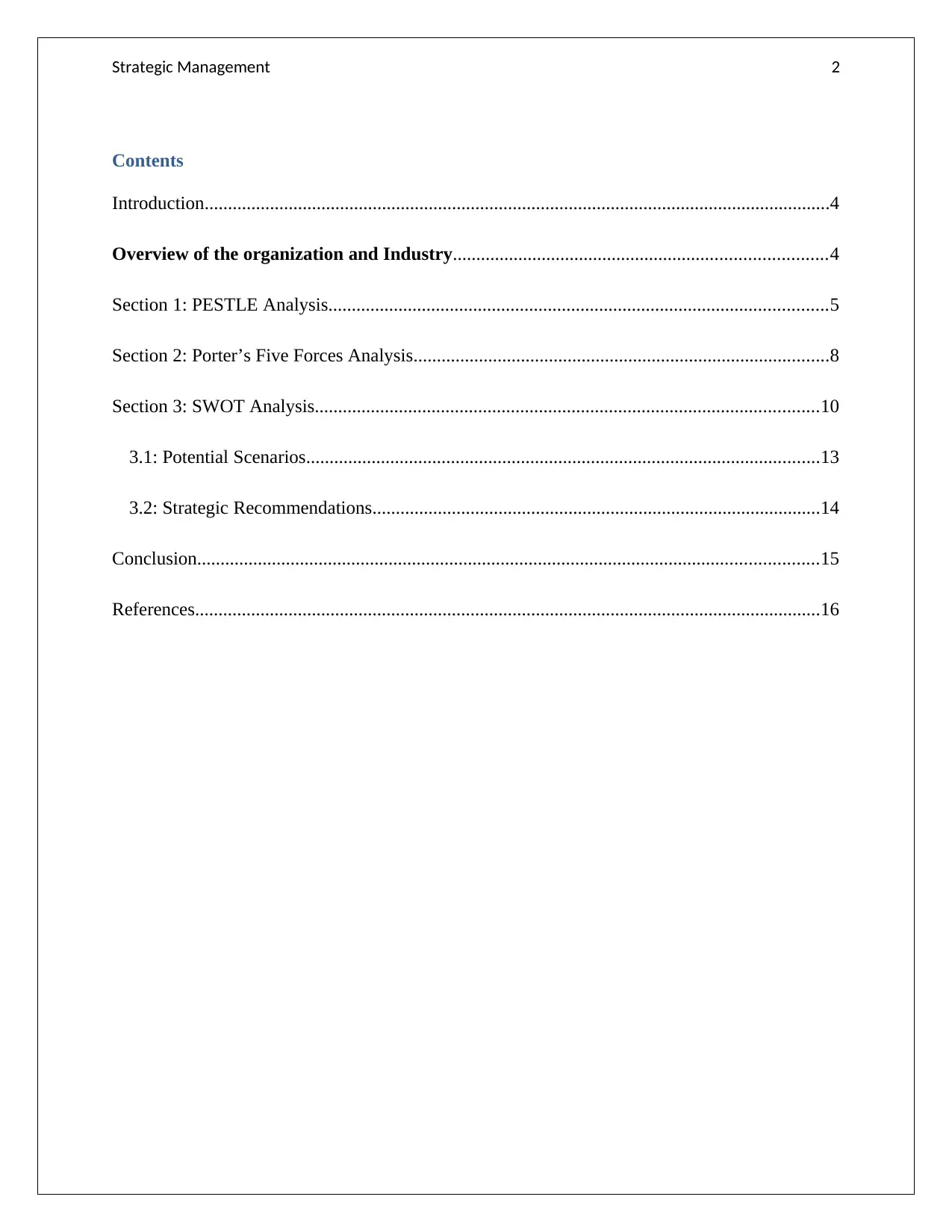
Strategic Management 2
Contents
Introduction......................................................................................................................................4
Overview of the organization and Industry................................................................................4
Section 1: PESTLE Analysis...........................................................................................................5
Section 2: Porter’s Five Forces Analysis.........................................................................................8
Section 3: SWOT Analysis............................................................................................................10
3.1: Potential Scenarios..............................................................................................................13
3.2: Strategic Recommendations................................................................................................14
Conclusion.....................................................................................................................................15
References......................................................................................................................................16
Contents
Introduction......................................................................................................................................4
Overview of the organization and Industry................................................................................4
Section 1: PESTLE Analysis...........................................................................................................5
Section 2: Porter’s Five Forces Analysis.........................................................................................8
Section 3: SWOT Analysis............................................................................................................10
3.1: Potential Scenarios..............................................................................................................13
3.2: Strategic Recommendations................................................................................................14
Conclusion.....................................................................................................................................15
References......................................................................................................................................16
⊘ This is a preview!⊘
Do you want full access?
Subscribe today to unlock all pages.

Trusted by 1+ million students worldwide
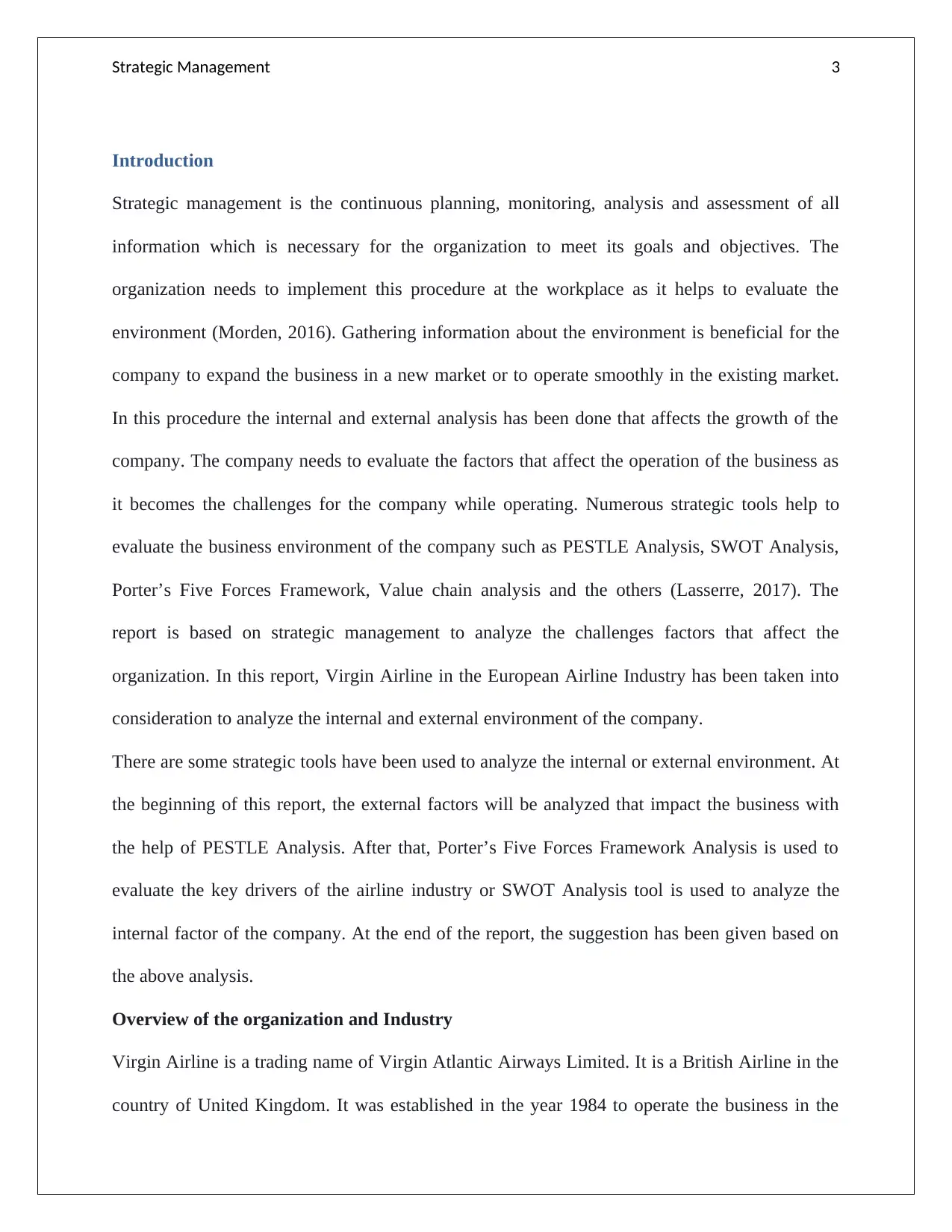
Strategic Management 3
Introduction
Strategic management is the continuous planning, monitoring, analysis and assessment of all
information which is necessary for the organization to meet its goals and objectives. The
organization needs to implement this procedure at the workplace as it helps to evaluate the
environment (Morden, 2016). Gathering information about the environment is beneficial for the
company to expand the business in a new market or to operate smoothly in the existing market.
In this procedure the internal and external analysis has been done that affects the growth of the
company. The company needs to evaluate the factors that affect the operation of the business as
it becomes the challenges for the company while operating. Numerous strategic tools help to
evaluate the business environment of the company such as PESTLE Analysis, SWOT Analysis,
Porter’s Five Forces Framework, Value chain analysis and the others (Lasserre, 2017). The
report is based on strategic management to analyze the challenges factors that affect the
organization. In this report, Virgin Airline in the European Airline Industry has been taken into
consideration to analyze the internal and external environment of the company.
There are some strategic tools have been used to analyze the internal or external environment. At
the beginning of this report, the external factors will be analyzed that impact the business with
the help of PESTLE Analysis. After that, Porter’s Five Forces Framework Analysis is used to
evaluate the key drivers of the airline industry or SWOT Analysis tool is used to analyze the
internal factor of the company. At the end of the report, the suggestion has been given based on
the above analysis.
Overview of the organization and Industry
Virgin Airline is a trading name of Virgin Atlantic Airways Limited. It is a British Airline in the
country of United Kingdom. It was established in the year 1984 to operate the business in the
Introduction
Strategic management is the continuous planning, monitoring, analysis and assessment of all
information which is necessary for the organization to meet its goals and objectives. The
organization needs to implement this procedure at the workplace as it helps to evaluate the
environment (Morden, 2016). Gathering information about the environment is beneficial for the
company to expand the business in a new market or to operate smoothly in the existing market.
In this procedure the internal and external analysis has been done that affects the growth of the
company. The company needs to evaluate the factors that affect the operation of the business as
it becomes the challenges for the company while operating. Numerous strategic tools help to
evaluate the business environment of the company such as PESTLE Analysis, SWOT Analysis,
Porter’s Five Forces Framework, Value chain analysis and the others (Lasserre, 2017). The
report is based on strategic management to analyze the challenges factors that affect the
organization. In this report, Virgin Airline in the European Airline Industry has been taken into
consideration to analyze the internal and external environment of the company.
There are some strategic tools have been used to analyze the internal or external environment. At
the beginning of this report, the external factors will be analyzed that impact the business with
the help of PESTLE Analysis. After that, Porter’s Five Forces Framework Analysis is used to
evaluate the key drivers of the airline industry or SWOT Analysis tool is used to analyze the
internal factor of the company. At the end of the report, the suggestion has been given based on
the above analysis.
Overview of the organization and Industry
Virgin Airline is a trading name of Virgin Atlantic Airways Limited. It is a British Airline in the
country of United Kingdom. It was established in the year 1984 to operate the business in the
Paraphrase This Document
Need a fresh take? Get an instant paraphrase of this document with our AI Paraphraser
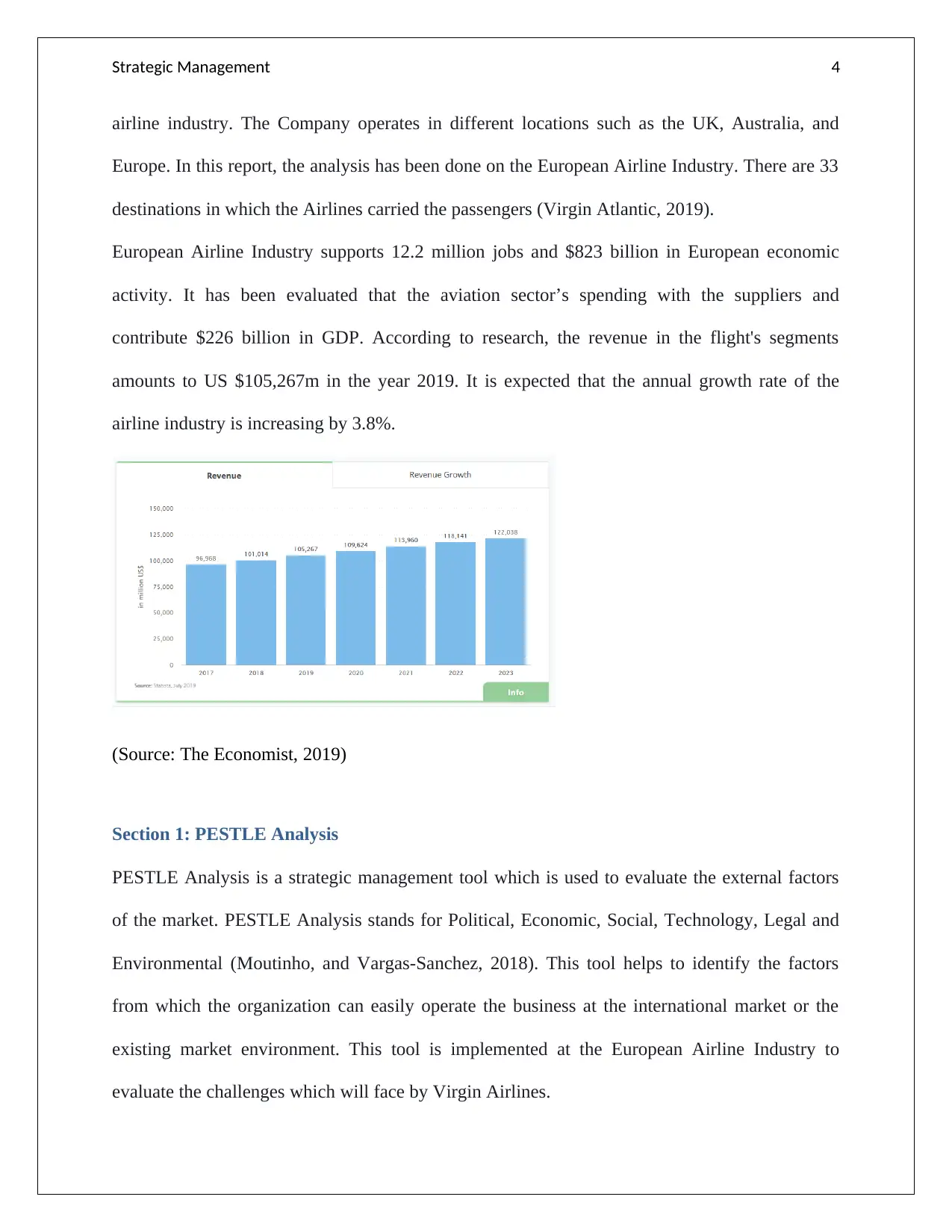
Strategic Management 4
airline industry. The Company operates in different locations such as the UK, Australia, and
Europe. In this report, the analysis has been done on the European Airline Industry. There are 33
destinations in which the Airlines carried the passengers (Virgin Atlantic, 2019).
European Airline Industry supports 12.2 million jobs and $823 billion in European economic
activity. It has been evaluated that the aviation sector’s spending with the suppliers and
contribute $226 billion in GDP. According to research, the revenue in the flight's segments
amounts to US $105,267m in the year 2019. It is expected that the annual growth rate of the
airline industry is increasing by 3.8%.
(Source: The Economist, 2019)
Section 1: PESTLE Analysis
PESTLE Analysis is a strategic management tool which is used to evaluate the external factors
of the market. PESTLE Analysis stands for Political, Economic, Social, Technology, Legal and
Environmental (Moutinho, and Vargas-Sanchez, 2018). This tool helps to identify the factors
from which the organization can easily operate the business at the international market or the
existing market environment. This tool is implemented at the European Airline Industry to
evaluate the challenges which will face by Virgin Airlines.
airline industry. The Company operates in different locations such as the UK, Australia, and
Europe. In this report, the analysis has been done on the European Airline Industry. There are 33
destinations in which the Airlines carried the passengers (Virgin Atlantic, 2019).
European Airline Industry supports 12.2 million jobs and $823 billion in European economic
activity. It has been evaluated that the aviation sector’s spending with the suppliers and
contribute $226 billion in GDP. According to research, the revenue in the flight's segments
amounts to US $105,267m in the year 2019. It is expected that the annual growth rate of the
airline industry is increasing by 3.8%.
(Source: The Economist, 2019)
Section 1: PESTLE Analysis
PESTLE Analysis is a strategic management tool which is used to evaluate the external factors
of the market. PESTLE Analysis stands for Political, Economic, Social, Technology, Legal and
Environmental (Moutinho, and Vargas-Sanchez, 2018). This tool helps to identify the factors
from which the organization can easily operate the business at the international market or the
existing market environment. This tool is implemented at the European Airline Industry to
evaluate the challenges which will face by Virgin Airlines.
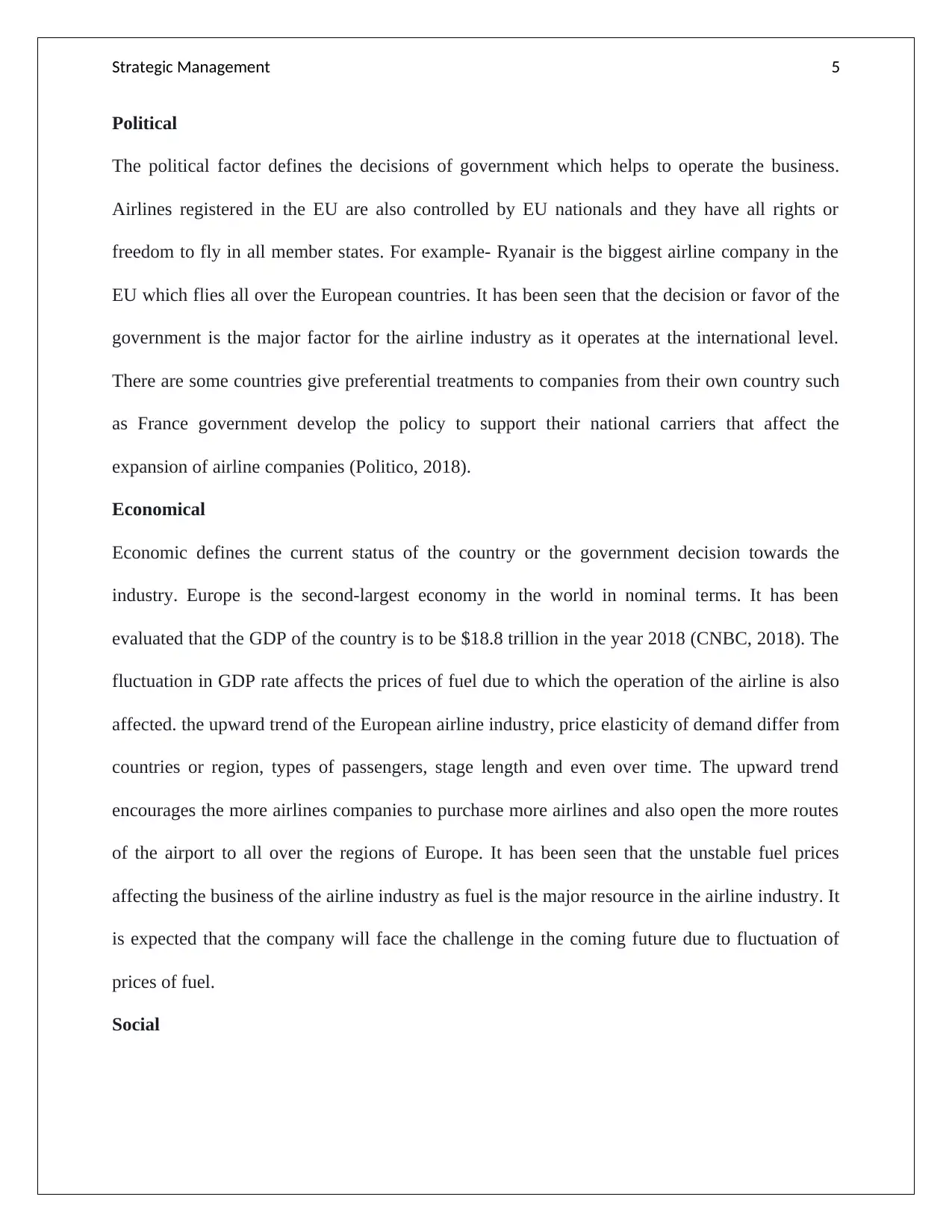
Strategic Management 5
Political
The political factor defines the decisions of government which helps to operate the business.
Airlines registered in the EU are also controlled by EU nationals and they have all rights or
freedom to fly in all member states. For example- Ryanair is the biggest airline company in the
EU which flies all over the European countries. It has been seen that the decision or favor of the
government is the major factor for the airline industry as it operates at the international level.
There are some countries give preferential treatments to companies from their own country such
as France government develop the policy to support their national carriers that affect the
expansion of airline companies (Politico, 2018).
Economical
Economic defines the current status of the country or the government decision towards the
industry. Europe is the second-largest economy in the world in nominal terms. It has been
evaluated that the GDP of the country is to be $18.8 trillion in the year 2018 (CNBC, 2018). The
fluctuation in GDP rate affects the prices of fuel due to which the operation of the airline is also
affected. the upward trend of the European airline industry, price elasticity of demand differ from
countries or region, types of passengers, stage length and even over time. The upward trend
encourages the more airlines companies to purchase more airlines and also open the more routes
of the airport to all over the regions of Europe. It has been seen that the unstable fuel prices
affecting the business of the airline industry as fuel is the major resource in the airline industry. It
is expected that the company will face the challenge in the coming future due to fluctuation of
prices of fuel.
Social
Political
The political factor defines the decisions of government which helps to operate the business.
Airlines registered in the EU are also controlled by EU nationals and they have all rights or
freedom to fly in all member states. For example- Ryanair is the biggest airline company in the
EU which flies all over the European countries. It has been seen that the decision or favor of the
government is the major factor for the airline industry as it operates at the international level.
There are some countries give preferential treatments to companies from their own country such
as France government develop the policy to support their national carriers that affect the
expansion of airline companies (Politico, 2018).
Economical
Economic defines the current status of the country or the government decision towards the
industry. Europe is the second-largest economy in the world in nominal terms. It has been
evaluated that the GDP of the country is to be $18.8 trillion in the year 2018 (CNBC, 2018). The
fluctuation in GDP rate affects the prices of fuel due to which the operation of the airline is also
affected. the upward trend of the European airline industry, price elasticity of demand differ from
countries or region, types of passengers, stage length and even over time. The upward trend
encourages the more airlines companies to purchase more airlines and also open the more routes
of the airport to all over the regions of Europe. It has been seen that the unstable fuel prices
affecting the business of the airline industry as fuel is the major resource in the airline industry. It
is expected that the company will face the challenge in the coming future due to fluctuation of
prices of fuel.
Social
⊘ This is a preview!⊘
Do you want full access?
Subscribe today to unlock all pages.

Trusted by 1+ million students worldwide
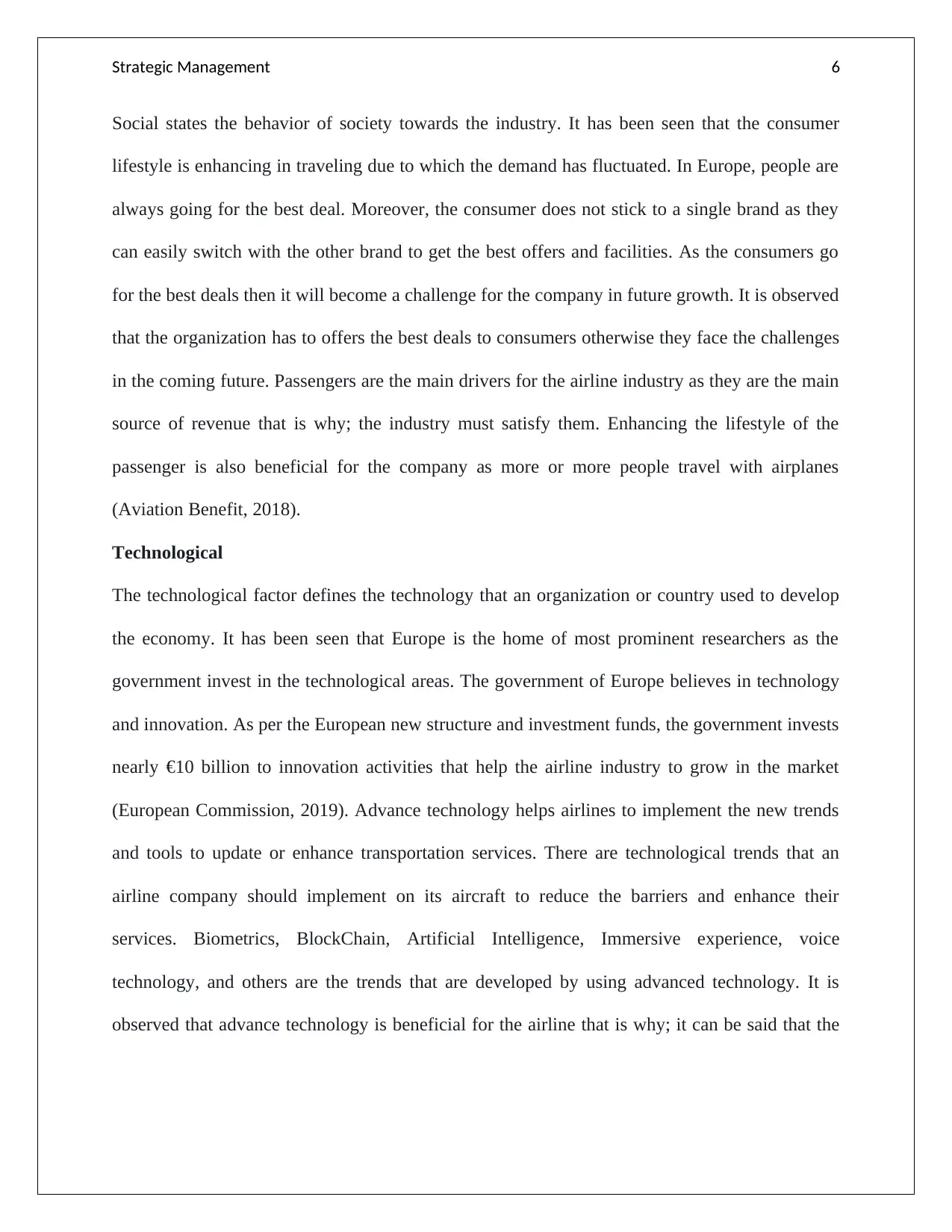
Strategic Management 6
Social states the behavior of society towards the industry. It has been seen that the consumer
lifestyle is enhancing in traveling due to which the demand has fluctuated. In Europe, people are
always going for the best deal. Moreover, the consumer does not stick to a single brand as they
can easily switch with the other brand to get the best offers and facilities. As the consumers go
for the best deals then it will become a challenge for the company in future growth. It is observed
that the organization has to offers the best deals to consumers otherwise they face the challenges
in the coming future. Passengers are the main drivers for the airline industry as they are the main
source of revenue that is why; the industry must satisfy them. Enhancing the lifestyle of the
passenger is also beneficial for the company as more or more people travel with airplanes
(Aviation Benefit, 2018).
Technological
The technological factor defines the technology that an organization or country used to develop
the economy. It has been seen that Europe is the home of most prominent researchers as the
government invest in the technological areas. The government of Europe believes in technology
and innovation. As per the European new structure and investment funds, the government invests
nearly €10 billion to innovation activities that help the airline industry to grow in the market
(European Commission, 2019). Advance technology helps airlines to implement the new trends
and tools to update or enhance transportation services. There are technological trends that an
airline company should implement on its aircraft to reduce the barriers and enhance their
services. Biometrics, BlockChain, Artificial Intelligence, Immersive experience, voice
technology, and others are the trends that are developed by using advanced technology. It is
observed that advance technology is beneficial for the airline that is why; it can be said that the
Social states the behavior of society towards the industry. It has been seen that the consumer
lifestyle is enhancing in traveling due to which the demand has fluctuated. In Europe, people are
always going for the best deal. Moreover, the consumer does not stick to a single brand as they
can easily switch with the other brand to get the best offers and facilities. As the consumers go
for the best deals then it will become a challenge for the company in future growth. It is observed
that the organization has to offers the best deals to consumers otherwise they face the challenges
in the coming future. Passengers are the main drivers for the airline industry as they are the main
source of revenue that is why; the industry must satisfy them. Enhancing the lifestyle of the
passenger is also beneficial for the company as more or more people travel with airplanes
(Aviation Benefit, 2018).
Technological
The technological factor defines the technology that an organization or country used to develop
the economy. It has been seen that Europe is the home of most prominent researchers as the
government invest in the technological areas. The government of Europe believes in technology
and innovation. As per the European new structure and investment funds, the government invests
nearly €10 billion to innovation activities that help the airline industry to grow in the market
(European Commission, 2019). Advance technology helps airlines to implement the new trends
and tools to update or enhance transportation services. There are technological trends that an
airline company should implement on its aircraft to reduce the barriers and enhance their
services. Biometrics, BlockChain, Artificial Intelligence, Immersive experience, voice
technology, and others are the trends that are developed by using advanced technology. It is
observed that advance technology is beneficial for the airline that is why; it can be said that the
Paraphrase This Document
Need a fresh take? Get an instant paraphrase of this document with our AI Paraphraser
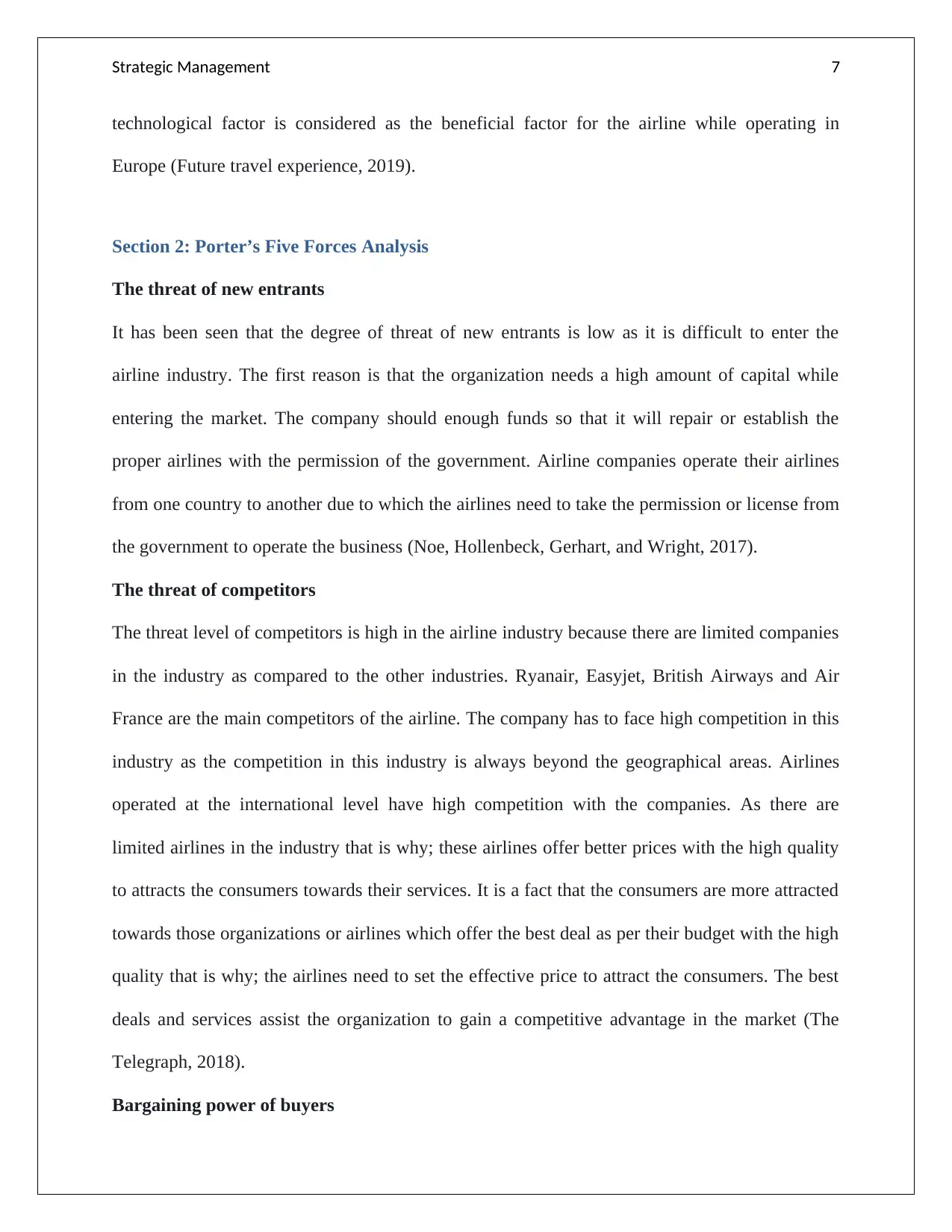
Strategic Management 7
technological factor is considered as the beneficial factor for the airline while operating in
Europe (Future travel experience, 2019).
Section 2: Porter’s Five Forces Analysis
The threat of new entrants
It has been seen that the degree of threat of new entrants is low as it is difficult to enter the
airline industry. The first reason is that the organization needs a high amount of capital while
entering the market. The company should enough funds so that it will repair or establish the
proper airlines with the permission of the government. Airline companies operate their airlines
from one country to another due to which the airlines need to take the permission or license from
the government to operate the business (Noe, Hollenbeck, Gerhart, and Wright, 2017).
The threat of competitors
The threat level of competitors is high in the airline industry because there are limited companies
in the industry as compared to the other industries. Ryanair, Easyjet, British Airways and Air
France are the main competitors of the airline. The company has to face high competition in this
industry as the competition in this industry is always beyond the geographical areas. Airlines
operated at the international level have high competition with the companies. As there are
limited airlines in the industry that is why; these airlines offer better prices with the high quality
to attracts the consumers towards their services. It is a fact that the consumers are more attracted
towards those organizations or airlines which offer the best deal as per their budget with the high
quality that is why; the airlines need to set the effective price to attract the consumers. The best
deals and services assist the organization to gain a competitive advantage in the market (The
Telegraph, 2018).
Bargaining power of buyers
technological factor is considered as the beneficial factor for the airline while operating in
Europe (Future travel experience, 2019).
Section 2: Porter’s Five Forces Analysis
The threat of new entrants
It has been seen that the degree of threat of new entrants is low as it is difficult to enter the
airline industry. The first reason is that the organization needs a high amount of capital while
entering the market. The company should enough funds so that it will repair or establish the
proper airlines with the permission of the government. Airline companies operate their airlines
from one country to another due to which the airlines need to take the permission or license from
the government to operate the business (Noe, Hollenbeck, Gerhart, and Wright, 2017).
The threat of competitors
The threat level of competitors is high in the airline industry because there are limited companies
in the industry as compared to the other industries. Ryanair, Easyjet, British Airways and Air
France are the main competitors of the airline. The company has to face high competition in this
industry as the competition in this industry is always beyond the geographical areas. Airlines
operated at the international level have high competition with the companies. As there are
limited airlines in the industry that is why; these airlines offer better prices with the high quality
to attracts the consumers towards their services. It is a fact that the consumers are more attracted
towards those organizations or airlines which offer the best deal as per their budget with the high
quality that is why; the airlines need to set the effective price to attract the consumers. The best
deals and services assist the organization to gain a competitive advantage in the market (The
Telegraph, 2018).
Bargaining power of buyers
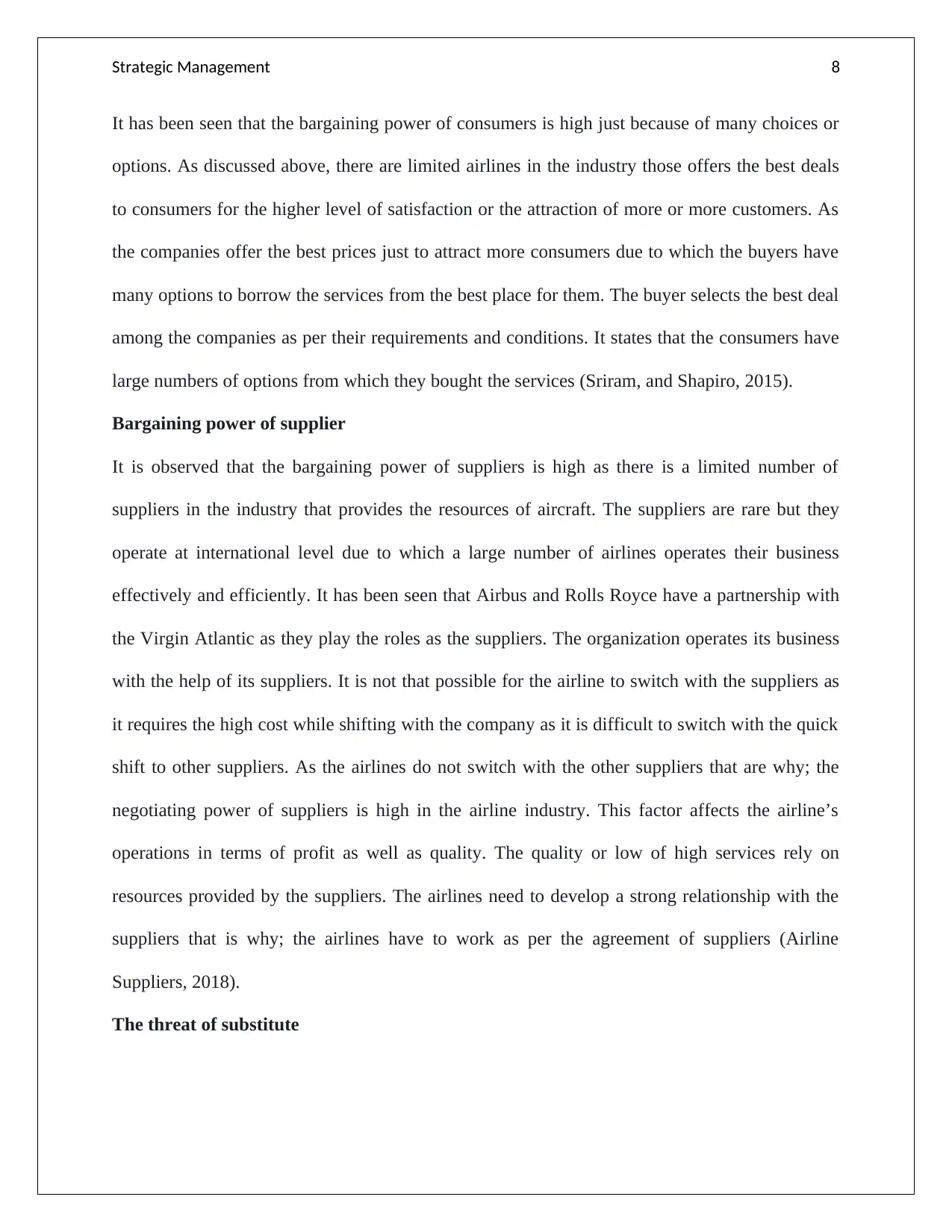
Strategic Management 8
It has been seen that the bargaining power of consumers is high just because of many choices or
options. As discussed above, there are limited airlines in the industry those offers the best deals
to consumers for the higher level of satisfaction or the attraction of more or more customers. As
the companies offer the best prices just to attract more consumers due to which the buyers have
many options to borrow the services from the best place for them. The buyer selects the best deal
among the companies as per their requirements and conditions. It states that the consumers have
large numbers of options from which they bought the services (Sriram, and Shapiro, 2015).
Bargaining power of supplier
It is observed that the bargaining power of suppliers is high as there is a limited number of
suppliers in the industry that provides the resources of aircraft. The suppliers are rare but they
operate at international level due to which a large number of airlines operates their business
effectively and efficiently. It has been seen that Airbus and Rolls Royce have a partnership with
the Virgin Atlantic as they play the roles as the suppliers. The organization operates its business
with the help of its suppliers. It is not that possible for the airline to switch with the suppliers as
it requires the high cost while shifting with the company as it is difficult to switch with the quick
shift to other suppliers. As the airlines do not switch with the other suppliers that are why; the
negotiating power of suppliers is high in the airline industry. This factor affects the airline’s
operations in terms of profit as well as quality. The quality or low of high services rely on
resources provided by the suppliers. The airlines need to develop a strong relationship with the
suppliers that is why; the airlines have to work as per the agreement of suppliers (Airline
Suppliers, 2018).
The threat of substitute
It has been seen that the bargaining power of consumers is high just because of many choices or
options. As discussed above, there are limited airlines in the industry those offers the best deals
to consumers for the higher level of satisfaction or the attraction of more or more customers. As
the companies offer the best prices just to attract more consumers due to which the buyers have
many options to borrow the services from the best place for them. The buyer selects the best deal
among the companies as per their requirements and conditions. It states that the consumers have
large numbers of options from which they bought the services (Sriram, and Shapiro, 2015).
Bargaining power of supplier
It is observed that the bargaining power of suppliers is high as there is a limited number of
suppliers in the industry that provides the resources of aircraft. The suppliers are rare but they
operate at international level due to which a large number of airlines operates their business
effectively and efficiently. It has been seen that Airbus and Rolls Royce have a partnership with
the Virgin Atlantic as they play the roles as the suppliers. The organization operates its business
with the help of its suppliers. It is not that possible for the airline to switch with the suppliers as
it requires the high cost while shifting with the company as it is difficult to switch with the quick
shift to other suppliers. As the airlines do not switch with the other suppliers that are why; the
negotiating power of suppliers is high in the airline industry. This factor affects the airline’s
operations in terms of profit as well as quality. The quality or low of high services rely on
resources provided by the suppliers. The airlines need to develop a strong relationship with the
suppliers that is why; the airlines have to work as per the agreement of suppliers (Airline
Suppliers, 2018).
The threat of substitute
⊘ This is a preview!⊘
Do you want full access?
Subscribe today to unlock all pages.

Trusted by 1+ million students worldwide
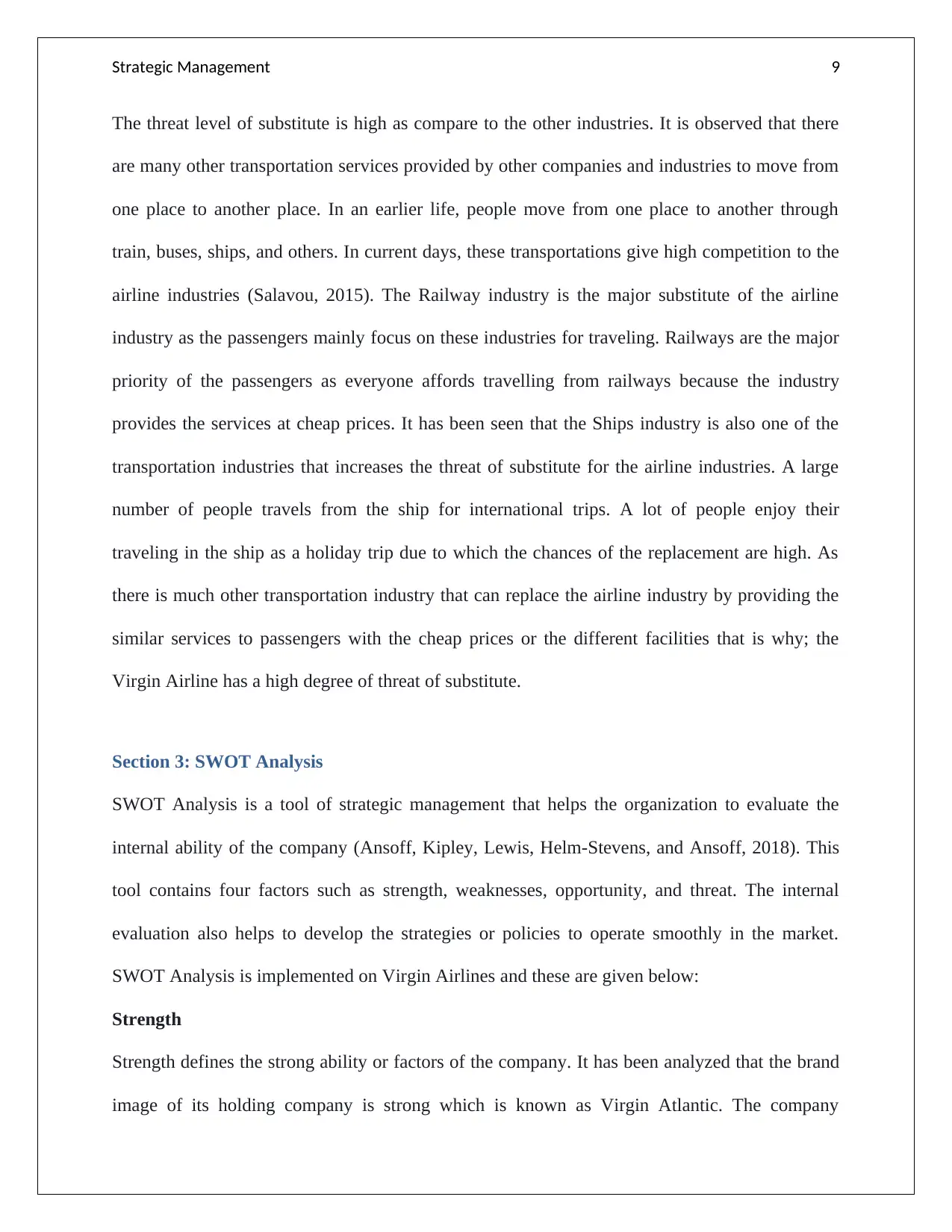
Strategic Management 9
The threat level of substitute is high as compare to the other industries. It is observed that there
are many other transportation services provided by other companies and industries to move from
one place to another place. In an earlier life, people move from one place to another through
train, buses, ships, and others. In current days, these transportations give high competition to the
airline industries (Salavou, 2015). The Railway industry is the major substitute of the airline
industry as the passengers mainly focus on these industries for traveling. Railways are the major
priority of the passengers as everyone affords travelling from railways because the industry
provides the services at cheap prices. It has been seen that the Ships industry is also one of the
transportation industries that increases the threat of substitute for the airline industries. A large
number of people travels from the ship for international trips. A lot of people enjoy their
traveling in the ship as a holiday trip due to which the chances of the replacement are high. As
there is much other transportation industry that can replace the airline industry by providing the
similar services to passengers with the cheap prices or the different facilities that is why; the
Virgin Airline has a high degree of threat of substitute.
Section 3: SWOT Analysis
SWOT Analysis is a tool of strategic management that helps the organization to evaluate the
internal ability of the company (Ansoff, Kipley, Lewis, Helm-Stevens, and Ansoff, 2018). This
tool contains four factors such as strength, weaknesses, opportunity, and threat. The internal
evaluation also helps to develop the strategies or policies to operate smoothly in the market.
SWOT Analysis is implemented on Virgin Airlines and these are given below:
Strength
Strength defines the strong ability or factors of the company. It has been analyzed that the brand
image of its holding company is strong which is known as Virgin Atlantic. The company
The threat level of substitute is high as compare to the other industries. It is observed that there
are many other transportation services provided by other companies and industries to move from
one place to another place. In an earlier life, people move from one place to another through
train, buses, ships, and others. In current days, these transportations give high competition to the
airline industries (Salavou, 2015). The Railway industry is the major substitute of the airline
industry as the passengers mainly focus on these industries for traveling. Railways are the major
priority of the passengers as everyone affords travelling from railways because the industry
provides the services at cheap prices. It has been seen that the Ships industry is also one of the
transportation industries that increases the threat of substitute for the airline industries. A large
number of people travels from the ship for international trips. A lot of people enjoy their
traveling in the ship as a holiday trip due to which the chances of the replacement are high. As
there is much other transportation industry that can replace the airline industry by providing the
similar services to passengers with the cheap prices or the different facilities that is why; the
Virgin Airline has a high degree of threat of substitute.
Section 3: SWOT Analysis
SWOT Analysis is a tool of strategic management that helps the organization to evaluate the
internal ability of the company (Ansoff, Kipley, Lewis, Helm-Stevens, and Ansoff, 2018). This
tool contains four factors such as strength, weaknesses, opportunity, and threat. The internal
evaluation also helps to develop the strategies or policies to operate smoothly in the market.
SWOT Analysis is implemented on Virgin Airlines and these are given below:
Strength
Strength defines the strong ability or factors of the company. It has been analyzed that the brand
image of its holding company is strong which is known as Virgin Atlantic. The company
Paraphrase This Document
Need a fresh take? Get an instant paraphrase of this document with our AI Paraphraser
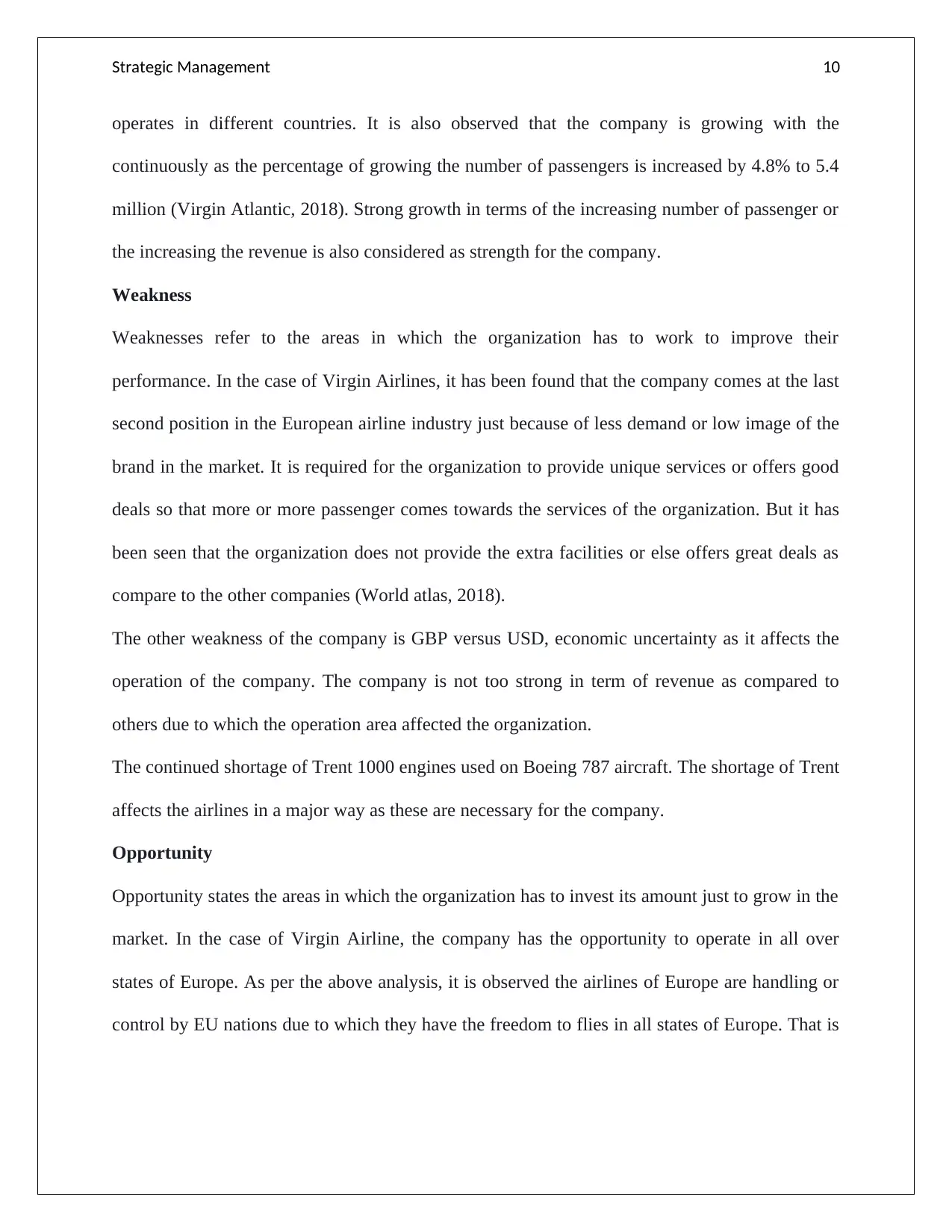
Strategic Management 10
operates in different countries. It is also observed that the company is growing with the
continuously as the percentage of growing the number of passengers is increased by 4.8% to 5.4
million (Virgin Atlantic, 2018). Strong growth in terms of the increasing number of passenger or
the increasing the revenue is also considered as strength for the company.
Weakness
Weaknesses refer to the areas in which the organization has to work to improve their
performance. In the case of Virgin Airlines, it has been found that the company comes at the last
second position in the European airline industry just because of less demand or low image of the
brand in the market. It is required for the organization to provide unique services or offers good
deals so that more or more passenger comes towards the services of the organization. But it has
been seen that the organization does not provide the extra facilities or else offers great deals as
compare to the other companies (World atlas, 2018).
The other weakness of the company is GBP versus USD, economic uncertainty as it affects the
operation of the company. The company is not too strong in term of revenue as compared to
others due to which the operation area affected the organization.
The continued shortage of Trent 1000 engines used on Boeing 787 aircraft. The shortage of Trent
affects the airlines in a major way as these are necessary for the company.
Opportunity
Opportunity states the areas in which the organization has to invest its amount just to grow in the
market. In the case of Virgin Airline, the company has the opportunity to operate in all over
states of Europe. As per the above analysis, it is observed the airlines of Europe are handling or
control by EU nations due to which they have the freedom to flies in all states of Europe. That is
operates in different countries. It is also observed that the company is growing with the
continuously as the percentage of growing the number of passengers is increased by 4.8% to 5.4
million (Virgin Atlantic, 2018). Strong growth in terms of the increasing number of passenger or
the increasing the revenue is also considered as strength for the company.
Weakness
Weaknesses refer to the areas in which the organization has to work to improve their
performance. In the case of Virgin Airlines, it has been found that the company comes at the last
second position in the European airline industry just because of less demand or low image of the
brand in the market. It is required for the organization to provide unique services or offers good
deals so that more or more passenger comes towards the services of the organization. But it has
been seen that the organization does not provide the extra facilities or else offers great deals as
compare to the other companies (World atlas, 2018).
The other weakness of the company is GBP versus USD, economic uncertainty as it affects the
operation of the company. The company is not too strong in term of revenue as compared to
others due to which the operation area affected the organization.
The continued shortage of Trent 1000 engines used on Boeing 787 aircraft. The shortage of Trent
affects the airlines in a major way as these are necessary for the company.
Opportunity
Opportunity states the areas in which the organization has to invest its amount just to grow in the
market. In the case of Virgin Airline, the company has the opportunity to operate in all over
states of Europe. As per the above analysis, it is observed the airlines of Europe are handling or
control by EU nations due to which they have the freedom to flies in all states of Europe. That is
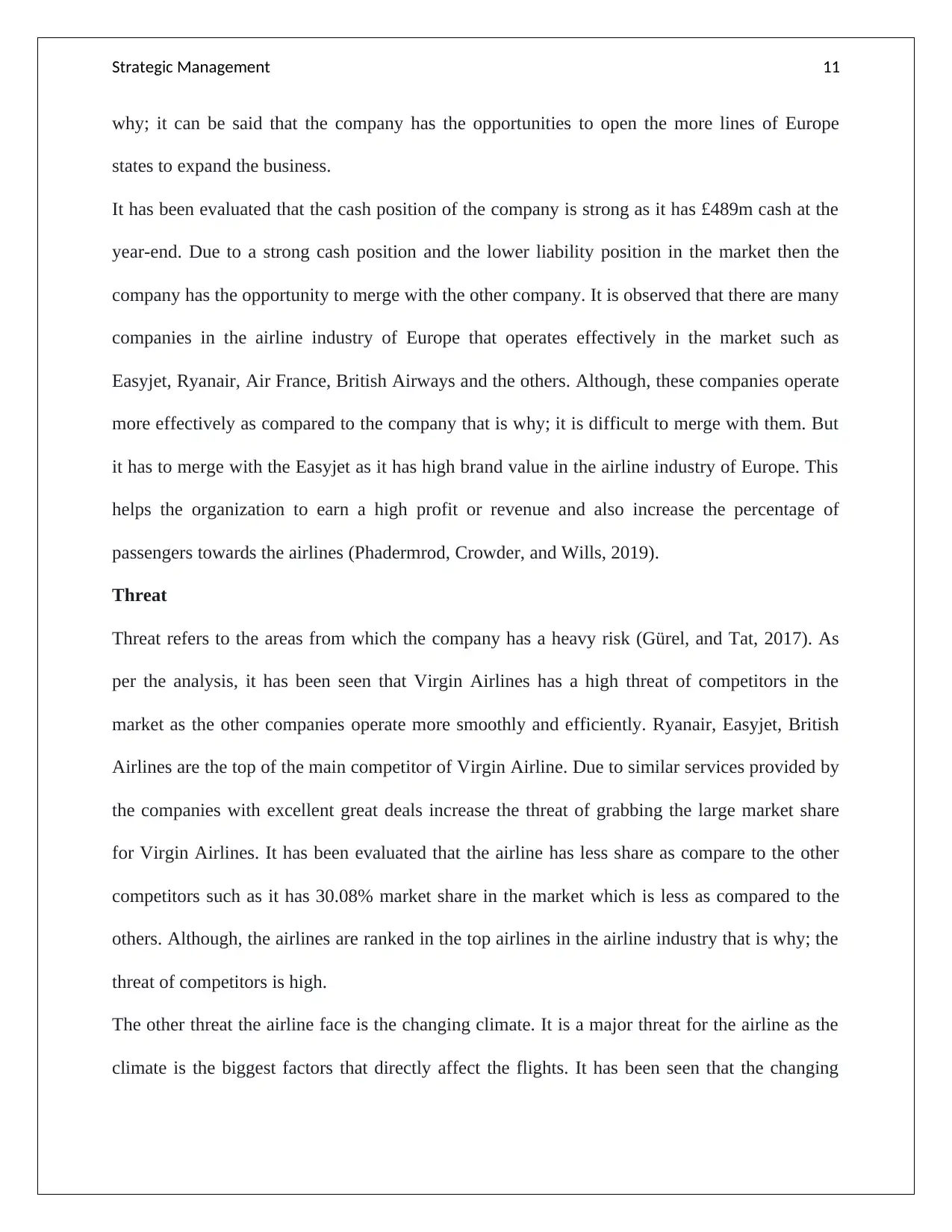
Strategic Management 11
why; it can be said that the company has the opportunities to open the more lines of Europe
states to expand the business.
It has been evaluated that the cash position of the company is strong as it has £489m cash at the
year-end. Due to a strong cash position and the lower liability position in the market then the
company has the opportunity to merge with the other company. It is observed that there are many
companies in the airline industry of Europe that operates effectively in the market such as
Easyjet, Ryanair, Air France, British Airways and the others. Although, these companies operate
more effectively as compared to the company that is why; it is difficult to merge with them. But
it has to merge with the Easyjet as it has high brand value in the airline industry of Europe. This
helps the organization to earn a high profit or revenue and also increase the percentage of
passengers towards the airlines (Phadermrod, Crowder, and Wills, 2019).
Threat
Threat refers to the areas from which the company has a heavy risk (Gürel, and Tat, 2017). As
per the analysis, it has been seen that Virgin Airlines has a high threat of competitors in the
market as the other companies operate more smoothly and efficiently. Ryanair, Easyjet, British
Airlines are the top of the main competitor of Virgin Airline. Due to similar services provided by
the companies with excellent great deals increase the threat of grabbing the large market share
for Virgin Airlines. It has been evaluated that the airline has less share as compare to the other
competitors such as it has 30.08% market share in the market which is less as compared to the
others. Although, the airlines are ranked in the top airlines in the airline industry that is why; the
threat of competitors is high.
The other threat the airline face is the changing climate. It is a major threat for the airline as the
climate is the biggest factors that directly affect the flights. It has been seen that the changing
why; it can be said that the company has the opportunities to open the more lines of Europe
states to expand the business.
It has been evaluated that the cash position of the company is strong as it has £489m cash at the
year-end. Due to a strong cash position and the lower liability position in the market then the
company has the opportunity to merge with the other company. It is observed that there are many
companies in the airline industry of Europe that operates effectively in the market such as
Easyjet, Ryanair, Air France, British Airways and the others. Although, these companies operate
more effectively as compared to the company that is why; it is difficult to merge with them. But
it has to merge with the Easyjet as it has high brand value in the airline industry of Europe. This
helps the organization to earn a high profit or revenue and also increase the percentage of
passengers towards the airlines (Phadermrod, Crowder, and Wills, 2019).
Threat
Threat refers to the areas from which the company has a heavy risk (Gürel, and Tat, 2017). As
per the analysis, it has been seen that Virgin Airlines has a high threat of competitors in the
market as the other companies operate more smoothly and efficiently. Ryanair, Easyjet, British
Airlines are the top of the main competitor of Virgin Airline. Due to similar services provided by
the companies with excellent great deals increase the threat of grabbing the large market share
for Virgin Airlines. It has been evaluated that the airline has less share as compare to the other
competitors such as it has 30.08% market share in the market which is less as compared to the
others. Although, the airlines are ranked in the top airlines in the airline industry that is why; the
threat of competitors is high.
The other threat the airline face is the changing climate. It is a major threat for the airline as the
climate is the biggest factors that directly affect the flights. It has been seen that the changing
⊘ This is a preview!⊘
Do you want full access?
Subscribe today to unlock all pages.

Trusted by 1+ million students worldwide
1 out of 19
Related Documents
Your All-in-One AI-Powered Toolkit for Academic Success.
+13062052269
info@desklib.com
Available 24*7 on WhatsApp / Email
![[object Object]](/_next/static/media/star-bottom.7253800d.svg)
Unlock your academic potential
Copyright © 2020–2025 A2Z Services. All Rights Reserved. Developed and managed by ZUCOL.





